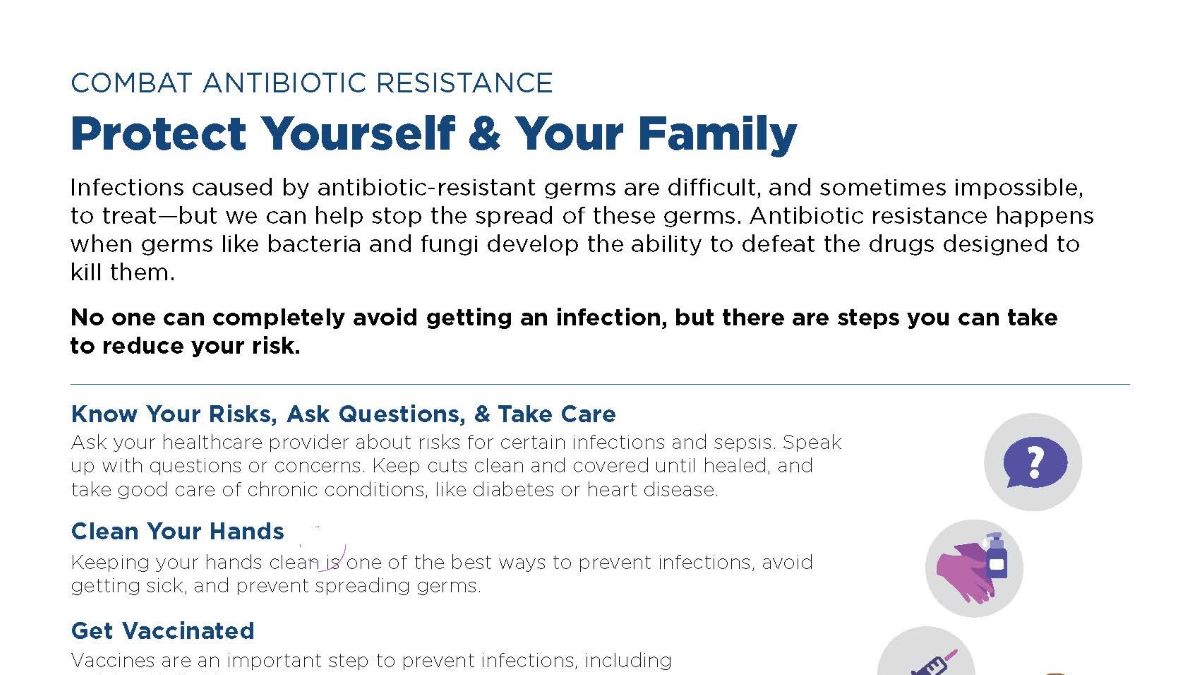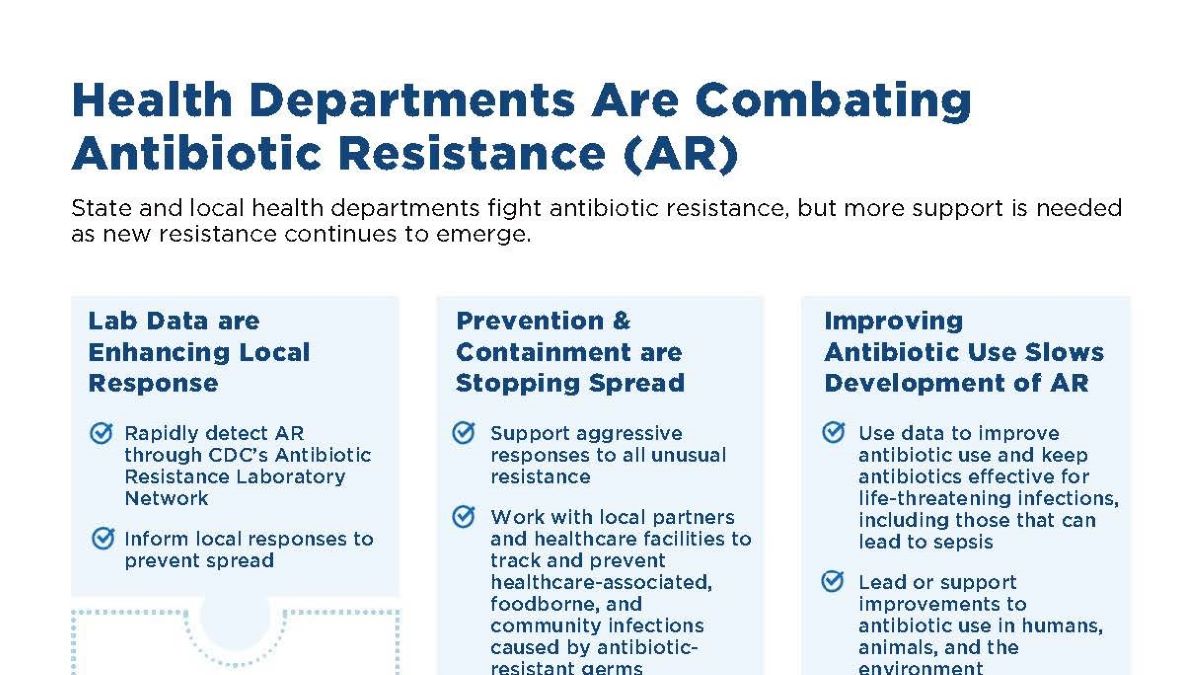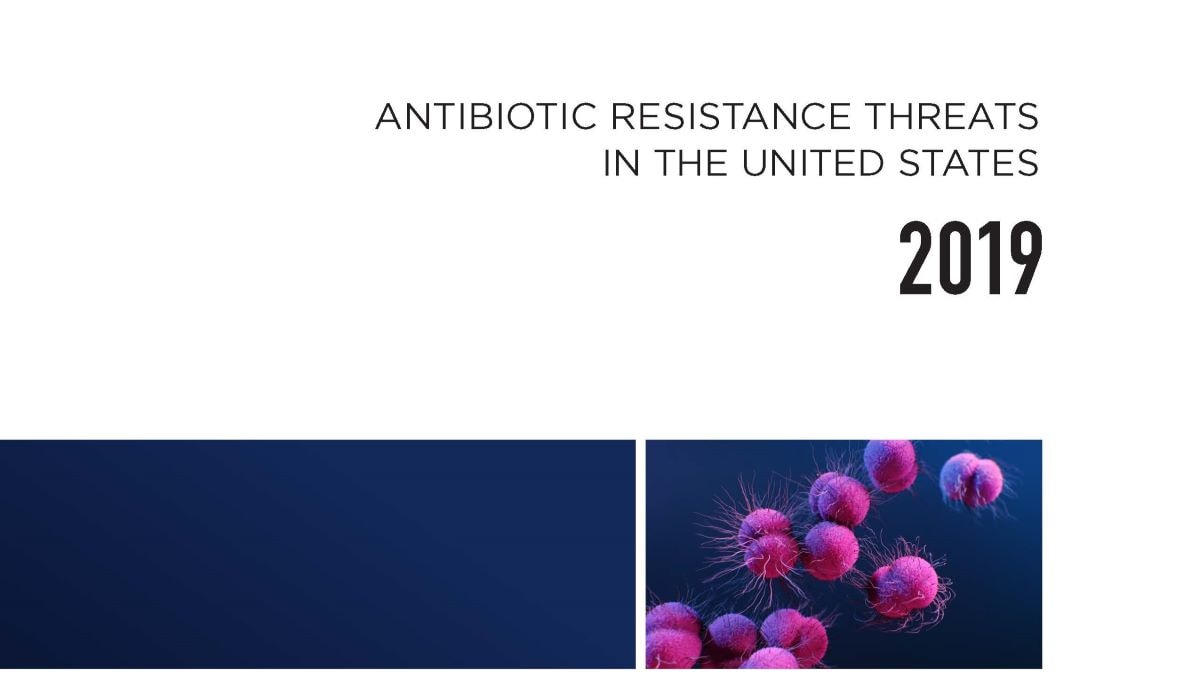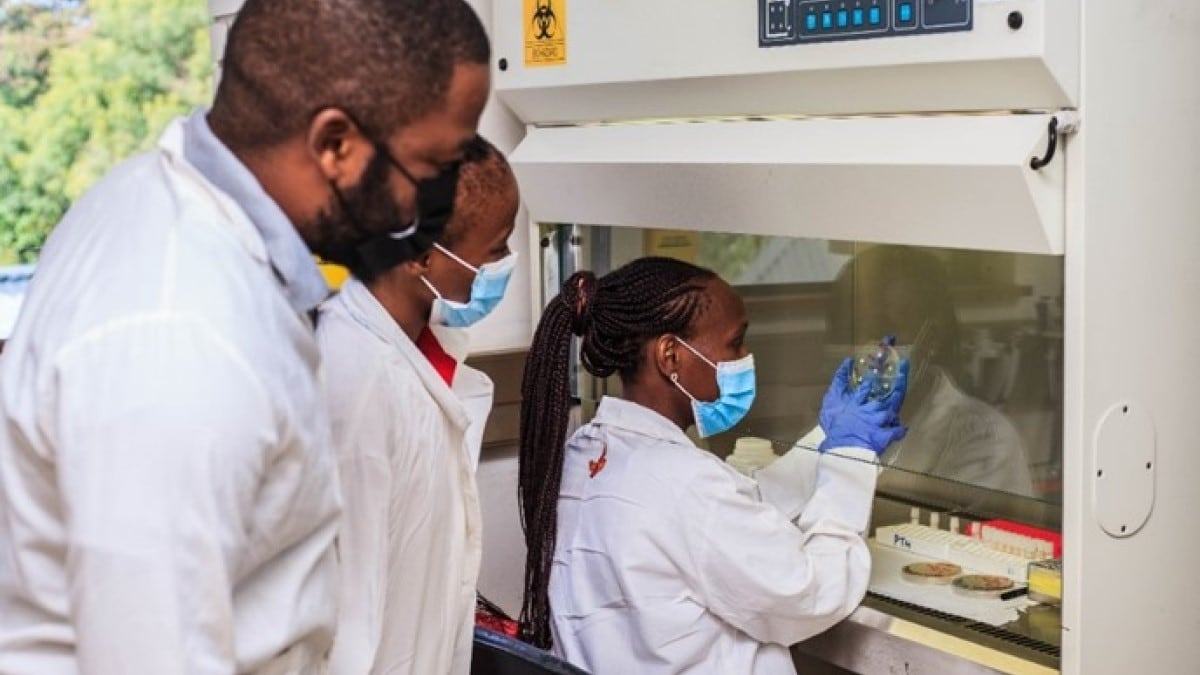Key points
- Antimicrobial resistance (AR) happens when germs bacteria and fungi develop the ability to defeat the drugs designed to kill them.
- AR has been found in every U.S. state and country. Addressing this threat requires continued aggressive action to prevent infections in the first place, improve antibiotic and antifungal use and stop the spread of resistance when it does develop.

Actions to combat AR
Infections caused by antimicrobial-resistant germs are difficult, and sometimes impossible, to treat.
No one can completely avoid getting an infection, but there are steps you can take to reduce your risk and help stop the spread of germs.
Protecting yourself, your family and others
Know your risk, ask questions and take care
- Keep cuts clean and covered until healed, and take good care of chronic conditions, like diabetes or heart disease.
- Speak up with questions or concerns.
- Ask your healthcare provider about risks for certain infections and sepsis, the body's extreme response to infection.
Clean your hands
- Keeping your hands clean is one of the best ways to remove germs, avoid getting sick and prevent spreading germs to others.
- Learn more about how washing your hands can fight germs that get on our hands every day.
Get vaccinated
- Vaccines are an important step to prevent infections, including resistant infections.
- Talk to your healthcare provider or your child's healthcare provider about vaccines recommended for all ages.
Use antibiotics and antifungals appropriately
- Talk with your healthcare provider about the best treatment when you or your family are sick.
- Talk with your veterinarian about the best treatment option when your animal is sick.
- Antibiotics and antifungals save lives, but any time they are used they can cause sides effects and contribute to antimicrobial resistance.
- One side effect is Clostridioides difficile—a bacterium that is not typically resistant but is associated with antibiotic use. C. diff can cause severe and deadly diarrhea, loss of appetite, abdominal pain/tenderness and nausea.
- Learn more about using antibiotics, including when they are needed and when they are not.
Be aware of changes in your health
- Talk to your healthcare provider about how to recognize signs and symptoms of infections, or if you think you have an infection.
- If an infection isn't stopped, it can lead to additional complications like sepsis, a life-threatening medical emergency.
Practice healthy habits around animals
- Always clean your hands after touching, feeding, or caring for animals. Take measures to reduce your contact with animal waste, like using gloves.
- Keep your animals and pets healthy.
- Talk to your veterinarian about AR and using antibiotics and antifungals only when needed to prevent risks to your animals/pets, including germs like carbapenem-resistant Enterobacterales (CRE).
Prepare food safely
Follow four simple steps to avoid foodborne infections—clean, separate, cook, and chill.
- Clean your hands, cooking utensils and surfaces.
- Wash your hands before and after touching raw meat, chicken and other poultry, seafood or eggs.
- Wash your countertops, cutting boards and utensils after preparing each food item.
- Wash your hands before and after touching raw meat, chicken and other poultry, seafood or eggs.
- Separate raw meat from other foods.
- Use one cutting board or plate for raw meat and another for food that will not be cooked before it's eaten. Don't put cooked meat on a plate that had raw meat on it.
- Germs from raw meat, poultry, seafood and eggs can spread to fruits, vegetables and other ready-to-eat foods unless you keep them separate.
- Use one cutting board or plate for raw meat and another for food that will not be cooked before it's eaten. Don't put cooked meat on a plate that had raw meat on it.
- Cook foods to safe temperatures. Use a food thermometer to make sure food is cooked to a safe internal temperature:
- 145°F for whole cuts of beef, pork, lamb and veal, such as steaks, chops, and roasts (then allow meat to rest for 3 minutes before carving or eating).
- 160°F for ground meats, such as beef and pork, and egg dishes.
- 165°F for poultry, including ground chicken and turkey.
- 145°F for whole cuts of beef, pork, lamb and veal, such as steaks, chops, and roasts (then allow meat to rest for 3 minutes before carving or eating).
- Chill leftovers and other foods promptly.
- Keep your refrigerator at 40°F or below and refrigerate food within 2 hours of cooking.
- Refrigerate within 1 hour if food is exposed to temperatures above 90°F (like a hot car or picnic).
- Keep your refrigerator at 40°F or below and refrigerate food within 2 hours of cooking.
Stay healthy when traveling abroad
- Be vigilant when traveling abroad.
- Know what vaccinations are needed, check health alerts, stick to safe food and drinks, plan in advance in case you get sick and learn about the risks of medical tourism.
- Visit CDC's Traveler's Health website for more information.
Prevent sexually transmitted infections (STIs)
- The only way to avoid STIs is to not have sex.
- If you have sex, lower your risk by choosing safer sexual activities and using condoms the right way from start to finish.
- You and your partner should be treated right away if you test positive for STIs to keep from getting infected again.
- Gonorrhea, a common bacterial STI can be resistant to the drugs designed to treat it.
- Learn effective strategies to reduce STI if risk for yourself and your partner.
Health departments combat AR
Health departments are critical partners to rapidly detect resistance threats, help improve antibiotic and antifungal use, lead local responses and stop the spread of germs.
Health departments across the U.S. combat antimicrobial resistance by:
- Participating in CDC's Antimicrobial Resistance Laboratory Network by submitting isolates.
- Supporting local responses to prevent spread.
- Supporting aggressive responses to all unusual resistance.
- Working with local partners and healthcare facilities to track and prevent healthcare-associated, foodborne and community infections caused by antimicrobial-resistant germs.
- Using data to improve antibiotic and antifungal use and keep them effective for life-threatening infections, including those that can lead to sepsis.
- Leading or supporting improvements to antibiotic and antifungal use in people, animals and plants.
Why prevention is important
AR has the potential to affect people at any stage of life, as well as the healthcare, veterinary and agriculture industries. This makes it one of the world's most urgent public health problems.
Bacteria and fungi do not have to be resistant to every antibiotic or antifungal to be dangerous. Resistance to even one antibiotic or antifungal treatment can mean serious problems. For example:
- Antimicrobial-resistant infections that require the use of second- and third-line treatments can harm patients by causing serious side effects, such as organ failure, and prolong care and recovery, sometimes for months.
- Many medical advances are dependent on the ability to fight infections using antibiotics, including joint replacements, organ transplants, cancer therapy, and the treatment of chronic diseases like diabetes, asthma, and rheumatoid arthritis.
- In some cases, antimicrobial-resistant infections have no treatment options.
If antibiotics and antifungals lose their effectiveness, then we lose the ability to treat infections and control these public health threats.
What CDC is doing
- Supporting state and local health departments to rapidly detect, respond and contain local AR threats.
- Investing to protect the United States and the world against antimicrobial resistance.
- Working with partners to drive aggressive action and empower the nation to respond to antimicrobial resistance.
- Funding initiatives and activities to combat antimicrobial resistance.
- Monitoring, tracking and publishing reports on antimicrobial resistance data.
Prevention actions still needed
The U.S. Government supports state and local health departments to rapidly detect, respond and contain local AR threats. However, new types of resistance are constantly emerging and spreading. More action is needed to protect people. For example:
- Addressing gaps in lab capacity that can allow germs to spread undetected.
- Supporting labs that need a specialized workforce to use new technologies.
- Accessing enhanced data tools to learn about resistant germs and affected people.
- Providing boots on the ground to stop spread when containment responses are labor intensive.
- Promoting lab-epidemiology coordination, which is essential to stop the spread of new threats.
- Improving antibiotic and antifungal use with tailored interventions.
- Tracking antibiotic and antifungal use in settings like nursing homes and long-term care facilities, which often does not exist or is difficult.




